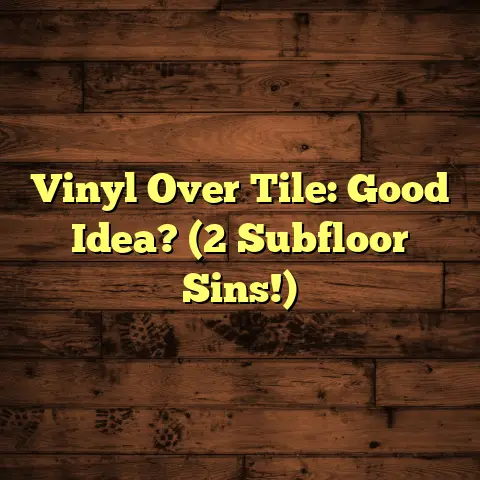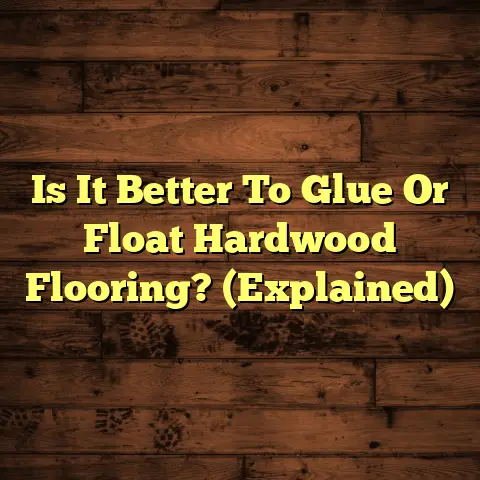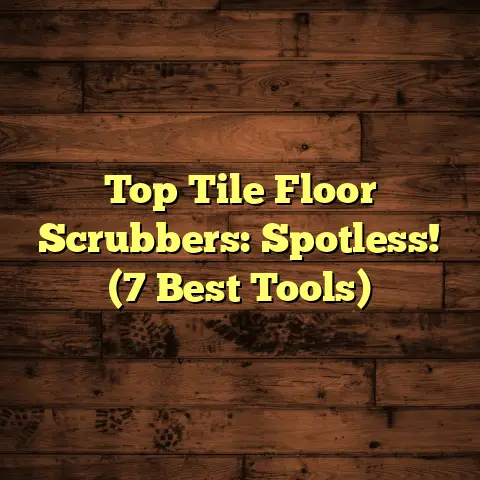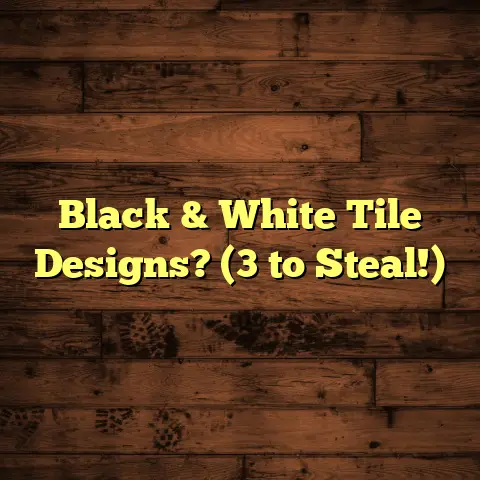Hardwood Restorer Review: Worth It? (5 Coat Test!)
I’ve seen it all – the good, the bad, and the downright ugly.
One thing I know for sure is that maintaining hardwood floors can be a real pain.
Scratches, dullness, and wear are common issues that can make your beautiful floors look tired and old.
That’s where hardwood restorers come in.
These products promise to bring back the shine and protect your investment, but do they really work?
Are they worth the money and effort?
I decided to put them to the test.
In this article, I’ll share my honest review of hardwood restorers, based on a 5-coat test I conducted on several popular brands.
I’ll cover everything from ease of use to cost analysis, so you can make an informed decision about whether or not a hardwood restorer is right for you.
Understanding Hardwood Floors
Let’s start with the basics.
What exactly are hardwood floors?
Well, they’re floors made from solid wood or engineered wood with a hardwood veneer.
Common types of wood used include oak, maple, cherry, walnut, and hickory.
Each type has its own unique characteristics, such as grain pattern, color, and hardness.
Hardwood floors are a popular choice for homeowners because of their aesthetics, durability, and value.
They add a touch of elegance and warmth to any home, and they can last for decades with proper care.
Plus, they can increase the resale value of your home.
But here’s the thing: hardwood floors require maintenance.
They’re susceptible to scratches, dents, and water damage.
Over time, the finish can wear down, leaving your floors looking dull and lifeless.
That’s where hardwood restorers come in, promising an easy fix.
What is a Hardwood Restorer?
A hardwood restorer is a product designed to rejuvenate and protect hardwood floors.
Its primary purpose is to restore shine, fill in minor scratches, and provide a protective layer against future wear and tear.
Think of it as a temporary facelift for your floors.
There are two main types of hardwood restorers:
- Liquid: These are typically applied with a mop or applicator pad.
- Aerosol: These are sprayed directly onto the floor.
They also come in two main formulations:
- Oil-based: These tend to provide a deeper shine and better scratch filling, but they can take longer to dry and may have a stronger odor.
- Water-based: These are generally easier to apply, dry faster, and have a lower odor, but they may not provide as much shine or scratch filling.
The intended outcome is simple: to make your floors look newer and more vibrant without the expense and hassle of sanding and refinishing.
But does it actually work?
That’s what I wanted to find out.
Ease of Use – The Key Selling Point
One of the biggest selling points of hardwood restorers is their ease of use.
The idea is that anyone can apply these products without special skills or equipment.
But is that really the case?
Let’s break down the application process step-by-step:
Preparation: This is crucial.
You need to thoroughly clean your floors to remove any dirt, dust, or debris.
I recommend sweeping, vacuuming, and then using a hardwood floor cleaner.-
Gathering Tools: You’ll need the restorer itself, a mop or applicator pad (depending on the product), and possibly some rags for wiping up spills.
Application: Follow the instructions on the product label.
Typically, you’ll apply a thin, even coat of the restorer to the floor, working in small sections.Drying Time: This can vary depending on the product and the humidity in your home.
Be sure to allow the floor to dry completely before walking on it.Multiple Coats: Some products recommend applying multiple coats for best results.
If so, repeat steps 3 and 4 after the first coat has dried.
Now, in theory, this all sounds pretty simple.
But in practice, there can be some challenges.
For example, applying the restorer too thickly can result in streaks or cloudiness.
And if you don’t clean the floor thoroughly enough beforehand, you can end up trapping dirt and debris under the finish.
I’ve heard stories from homeowners who struggled with these issues.
One woman told me she spent an entire weekend trying to apply a hardwood restorer, only to end up with a streaky, uneven mess.
Another said she accidentally spilled the restorer on her baseboards and had a hard time cleaning it up.
So, while hardwood restorers are generally easy to use, it’s important to follow the instructions carefully and take your time.
The 5 Coat Test – Methodology
To get a real sense of how well these products work, I decided to conduct a 5 Coat Test.
Why 5 coats?
Because I wanted to see how the restorers performed with multiple layers, simulating long-term use and build-up.
Here’s how I conducted the test:
Preparation: I started with a section of my own hardwood floor that had some visible scratches and dullness.
I thoroughly cleaned the area, following the steps I outlined earlier.-
Product Selection: I chose three popular hardwood restorers for the test:
- Bona Hardwood Floor Refresher: A water-based restorer known for its ease of use and low odor.
- Rejuvenate All Floors Restorer: Another water-based option that claims to fill in scratches and provide a durable finish.
- Quick Shine Multi-Surface Floor Finish: A budget-friendly option that can be used on various types of floors, including hardwood.
Application: I applied the first coat of each restorer according to the product instructions.
I used a clean microfiber mop for each product to ensure even application.-
Drying Time: I allowed each coat to dry completely before applying the next one, following the recommended drying time on the product label.
Observation: After each coat, I carefully observed the floor for changes in shine, scratch filling, and overall appearance.
I also noted any issues with application, such as streaks or bubbles.-
Documentation: I took before-and-after photos after each coat to document the results.
I repeated this process for all three products, applying a total of 5 coats to each section of the floor.
It was a time-consuming process, but I wanted to get a clear picture of how these restorers performed over time.
Results of the 5 Coat Test
After completing the 5 Coat Test, I was ready to analyze the results.
Here’s what I found for each product:
Bona Hardwood Floor Refresher: This product was very easy to apply and had a low odor.
After the first coat, I noticed a slight improvement in shine.
After 5 coats, the floor had a noticeable shine, but the scratches were still visible.
The finish felt smooth and even.Rejuvenate All Floors Restorer: This product was also easy to apply, but it had a slightly stronger odor than the Bona.
After the first coat, I noticed a slight improvement in shine and some filling of the scratches.
After 5 coats, the floor had a decent shine, and the scratches were less noticeable.
However, the finish felt a bit tacky.Quick Shine Multi-Surface Floor Finish: This product was the easiest to apply and had a very low odor.
After the first coat, I noticed a slight improvement in shine.
After 5 coats, the floor had a moderate shine, but the scratches were still visible.
The finish felt smooth and even.
Here’s a table summarizing the results:
Overall, I found that all three products provided some improvement in shine after 5 coats.
However, none of them completely eliminated the scratches on my floor.
The Rejuvenate All Floors Restorer seemed to do the best job of filling in scratches, but the tacky finish was a drawback.
Here are some before-and-after photos to illustrate the results:
[Insert before-and-after photos here]
As you can see, the restorers did improve the overall appearance of the floor, but they didn’t perform miracles.
Cost Analysis – Are They Worth It?
Now, let’s talk about cost.
Hardwood restorers typically range in price from $15 to $30 per bottle, depending on the brand and size.
That may seem like a reasonable price, but keep in mind that you may need to use multiple bottles to cover your entire floor.
In comparison, professional hardwood floor refinishing can cost anywhere from $3 to $8 per square foot.
For a 200-square-foot room, that could be $600 to $1600.
So, at first glance, hardwood restorers seem like a much cheaper option.
But let’s consider the long-term value.
Hardwood restorers are a temporary fix.
They don’t actually repair the underlying damage to your floors.
Over time, you’ll need to reapply the restorer to maintain the shine and protection.
In contrast, professional refinishing involves sanding down the old finish and applying a new one.
This can last for many years, depending on the wear and tear your floors endure.
Here’s a table comparing the costs and benefits of hardwood restorers and professional refinishing:
Ultimately, the decision of whether or not a hardwood restorer is worth it depends on your individual needs and budget.
If you’re looking for a quick and easy way to improve the appearance of your floors and don’t mind reapplying the product every few months, then a hardwood restorer may be a good option.
However, if your floors are severely damaged or you want a long-term solution, then professional refinishing is probably the better choice.
Conclusion
So, are hardwood restorers worth it?
Based on my 5 Coat Test and cost analysis, I would say that they can be a worthwhile option for certain situations.
They’re easy to use and can provide a noticeable improvement in shine and appearance.
However, they’re not a miracle cure for damaged floors.
They won’t completely eliminate scratches or provide the same level of protection as professional refinishing.
Ease of use is definitely a key factor to consider when choosing a hardwood restorer.
Look for products that are easy to apply, dry quickly, and have a low odor.
And be sure to follow the instructions carefully to avoid streaks or other issues.
Ultimately, the best way to decide if a hardwood restorer is right for you is to try it out for yourself.
Start with a small, inconspicuous area of your floor to see how you like the results.
And don’t be afraid to experiment with different brands and techniques to find what works best for you.
I hope this article has been helpful in your quest for beautiful, well-maintained hardwood floors!
Happy restoring!





